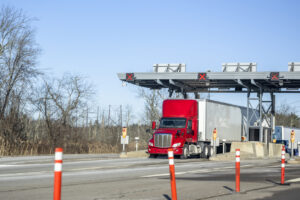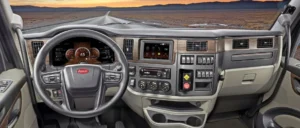ELYRIA, Ohio — Every day, the global commercial vehicle industry makes new technological strides toward improving truck, driver, and roadway safety – and none of this progress takes place in a vacuum.
Developments in active safety technology, the science of brake performance and advanced systems’ interactions with the professional men and women at the wheel are just a few of the interconnected aspects that Bendix continually addresses in its research, development and industry conversations across North America.
Recently, the company shared its latest insights on the rapidly evolving world of advanced safety technologies.
What’s happening in the cab?
Whether they’re providing alerts or warnings about speed over the posted limit, following distance, lane departure or objects in the blind spot, today’s collision mitigation systems communicate with drivers in a variety of ways.
These include audible, visual and haptic feedback, such as a “rumble strip” vibration in the steering wheel. On the surface, they seem uncomplicated – a beep, a blink, or a buzz – but these Human-Machine Interfaces (HMI) are increasingly important as technology advances.
“Ultimately, an HMI has a single goal: To quickly and simply get a driver’s attention and engagement,” said Fred Andersky, Bendix director of marketing and customer solutions – controls, who addressed the topic during the American Trucking Associations’ 2018 Technology Maintenance Council (TMC) Annual Meeting and Transportation Technology Exhibition in Atlanta. “While today’s systems – and those for the foreseeable future – provide advanced driver assistance and even interventions like braking, they’re still far from driver replacement, which means ensuring they work effectively with drivers is just as important as the actions they can take on their own.”
Integrated driver assistance systems like Bendix Wingman Fusion use an integrated approach to HMI. Based on the most critical event, a warning indication icon and tones give the driver the most critical warnings and suppress the least critical. The HMI can also convey other information, including distance to a forward object, speed, and system intervention status.
Some vehicle manufacturers offering advanced driver assistance systems as standard have incorporated the HMI into their dashboards to accommodate the wide range of alerts and information.
As the industry moves toward increasing vehicle automation, Andersky observed, it’s worth considering whether HMI should be a competitive differentiator or become more standardized. More uniform interfaces could help lower the possibility for issues as drivers move between vehicles equipped with these systems and simplify the delivery of vital information.
One example of future simplification and standardization on this front is the Bendix Intellipark automatic electronic parking brake. The technology replaces the familiar manual air parking brake with easy-to-apply electronic switches, and works through interlocks installed in critical areas, such as the seat, seat belt, or cab door to engage the brake if the driver leaves the seat or opens the door without setting it first. Intellipark also brings HMI elements to the parking brake system, delivering visual alerts to the driver through lights on the switch and a trailer air warning that indicates the status of the trailer’s air supply.
What’s going on at the wheel-ends?
The effectiveness of current and future active safety systems relies in large part on the performance of a vehicle’s foundation brakes: Stopping power, consistency, and – in the not-too-distant future – steering will all be impacted by the selection and combination of wheel-end components.
“For decades, Bendix has emphasized the importance of balance in air-braked systems, because safety and performance depend on precise and equal brake activation,” said Joey Campbell, product manager of air disc brakes at Bendix Spicer Foundation Brake LLC, who also presented at the TMC meeting, as well as the 2018 CVSA Brake Safety Symposium in Illinois. “In the age of electronically controlled braking – from antilock brakes to full-stability and collision mitigation – making sure each wheel-end is performing optimally takes on even greater importance.”
While air disc brakes (ADB) are recognized as providing better stopping power than traditional drum brakes – and adoption is increasing – the large majority of North American tractor and trailer wheels are equipped with drums. This means that as fleets and drivers encounter mixed-and-matched combinations of discs and drums on tractors and trailers, they need to know what to expect from these “hybrid” braking solutions.
Under normal brake operations, all the wheel-ends in a properly balanced brake system take on an equal amount of the workload, no matter whether they are discs or drums, or on the tractor or trailer. In heavy braking operation, however – descending mountains, for instance – drum brakes can heat up and exhibit decreased performance known as brake fade. This has the effect of shifting extra work onto the disc brakes to maintain the stopping power, and could mean shorter ADB pad life.
While it is possible to deliberately imbalance the air system to compensate for drum brake fade, Campbell stresses that Bendix doesn’t recommend it.
“For one thing, that brake fade situation is temporary, and it only exists for a small percentage of a vehicle’s operating time,” he said. “So this approach means you’ve created a work imbalance between the discs and drums during normal operation to fix a problem that only exists during a small percentage of application. And the majority of your time on the road, you want that air system balanced to optimize the performance of not just the brakes, but the advanced safety systems they’re ultimately supporting.”
What’s around the next bend?
Bendix’s current flagship advanced driver assistance system is Bendix® Wingman® Fusion™. The technology uses forward-facing camera and radar, as well as wheel-end sensors to combine and cross-check information from multiple sources, delivering enhanced rear-end collision mitigation, alerts when speeding, and braking on stationary vehicles. And since it’s built on the foundational full-stability technology of Bendix ESP, Fusion also helps drivers avoid additional crash situations, including rollovers and loss-of-control. Fusion’s camera is powered by the Mobileye System-on-Chip EyeQ processor with state-of-the-art vision algorithms.
With Fusion already providing a road-tested and reliable suite of safety technologies, the stage is set for its next steps forward. Speaking at the series of Great West Casualty Company’s Trucking Leadership Symposiums, and to the Iowa Motor Truck Association, Andersky offered a look around the next bend of the road to highly automated driving, discussing features of the forthcoming next-generation Fusion system.
“Multi-lane Automatic Emergency Braking (AEB) will be another example of how the deep integration of different sensor technologies enables more advanced capabilities,” Andersky said. “Say your truck is in the center lane and approaching a slow or stopped vehicle in its lane: If the system also detects that there is no clear route available in the adjacent lanes, it will use this information to continue autonomous emergency braking through any lane changes. Additionally, enhancements to the AEB capabilities enable speed reductions up to 50 mph on moving, as well as stationary vehicles.”
Other advances include highway departure braking, which builds upon the existing lane departure warning to alert the driver and activate the brakes if the vehicle leaves the roadway, and stop-and-go with driver release capabilities added to automatic cruise control (ACC). The latter will increase the usable speed range of ACC for maintaining distance in high-traffic congestion, plus bring the vehicle to a complete stop. Forthcoming Fusion advancements will also lead to linking the next generation of Bendix™ BlindSpotter® Side Object Detection System, integrating data from the side-radar unit to help drivers mitigate side-swipe and blind spot crashes.
“Advancements like these also point to the importance of strong foundational sensor technologies, because they’re achieved solely through software and computing power enhancements,” Andersky said. “The next generation won’t involve any hardware replacements or upgrades – the building blocks are already in place for the future. In the future, however, both hardware and software will continue to evolve to drive even more automation.”
Why do these things matter?
Even as technology advances, there’s no replacement for skilled, alert drivers practicing safe driving habits, and supported by proactive, ongoing training programs. And no advanced driver assistance system is intended to enable or encourage aggressive driving. The men and women behind the wheel today and tomorrow are the standard-bearers of vehicle and highway safety, and responsibility for safe vehicle operation remains with them at all times. However, this doesn’t mean that there aren’t significant and far-reaching benefits of increasingly automated driving technologies. In a keynote presentation during this year’s Canadian Fleet Maintenance Summit during the Truck World trade show in Ontario, Andersky discussed the positive impacts for society, fleets, and commercial vehicle drivers.
“Driver assistance does not equal driver replacement – not by a long shot,” said Andersky, who holds a Class A CDL and often drives demonstrations of Bendix systems. “And these technologies can make a real difference in the safety, productivity, wellness, and growth of truck drivers. They can help keep good drivers from having a bad day, reduce fatigue, and encourage skill maintenance and improvement through the information they provide on driving habits.”
Fleets equipping advanced driver assistance systems are seeing reduced accident rates, less severe collisions, and increased driver retention. Bendix has heard from customer fleets using Wingman Fusion that they’ve seen as much as a 90 percent reduction in rear-end collisions, and significant reduction in severity of those that did occur. And drivers both experienced and new have quickly embraced the technologies, describing them as invaluable tools that have changed their behind-the-wheel experiences for the better.
Benefits beyond the trucking industry extend to reduced emissions – since aspects like cruise control help engines work more efficiently – and ultimately, safer roads for all travelers. A recent Federal Motor Carrier Safety Administration report showed that from 2015 to 2016, the number of fatal crashes involving large trucks or buses increased by 6 percent – but also noted that for 73 percent of the large trucks in fatal crashes, the “critical pre-crash event” was another vehicle, person, animal, or object in the large truck’s lane or encroaching into it.
“The most experienced, highly skilled driver out there still can’t control everything else on the road; and we all share the same human limitations when it comes to things like reaction time,” Andersky said. “But what we can do as an industry is equip vehicles that are driver-supportive and proven to be safer for everyone sharing the highways.”
Bendix delivers on areas critical to fleets – including safety, vehicle performance, and efficiency – through its ever-growing portfolio of technology developments and unparalleled post-sales support. The company has worked for nearly 90 years to make travel safer for everyone by helping to lower the total cost of commercial vehicle ownership and strengthening return on investment in safety technologies.
For more information about Bendix safety systems and technologies, call 1-800-AIR-BRAKE (1-800-247-2725) or visit www.bendix.com or safertrucks.com/solutions. Visit the Bendix multimedia center at knowledge-dock.com for further insight on advanced safety technology development, driver assistance systems, and commercial vehicle safety regulations.
The Trucker News Staff produces engaging content for not only TheTrucker.com, but also The Trucker Newspaper, which has been serving the trucking industry for more than 30 years. With a focus on drivers, the Trucker News Staff aims to provide relevant, objective content pertaining to the trucking segment of the transportation industry. The Trucker News Staff is based in Little Rock, Arkansas.














